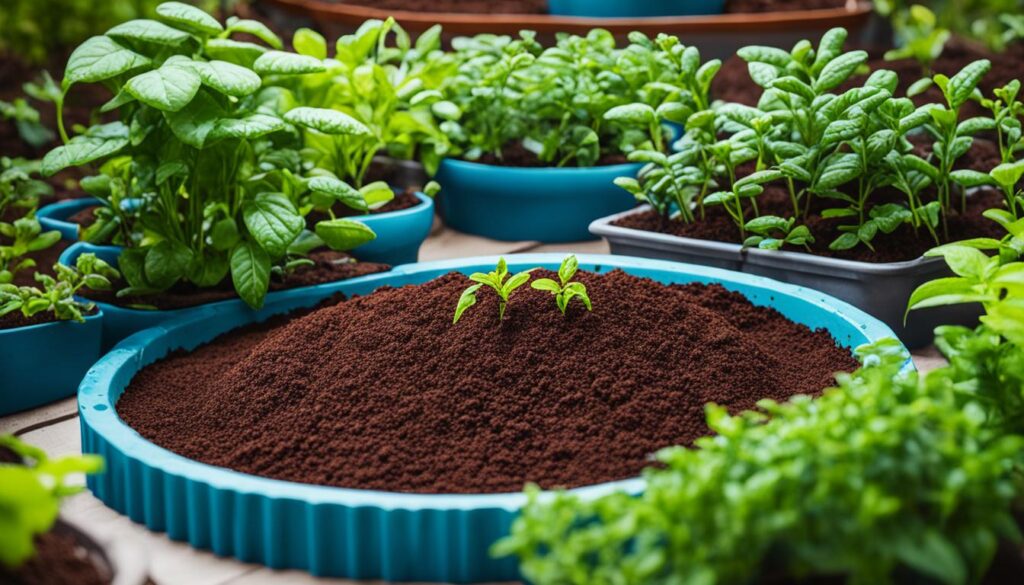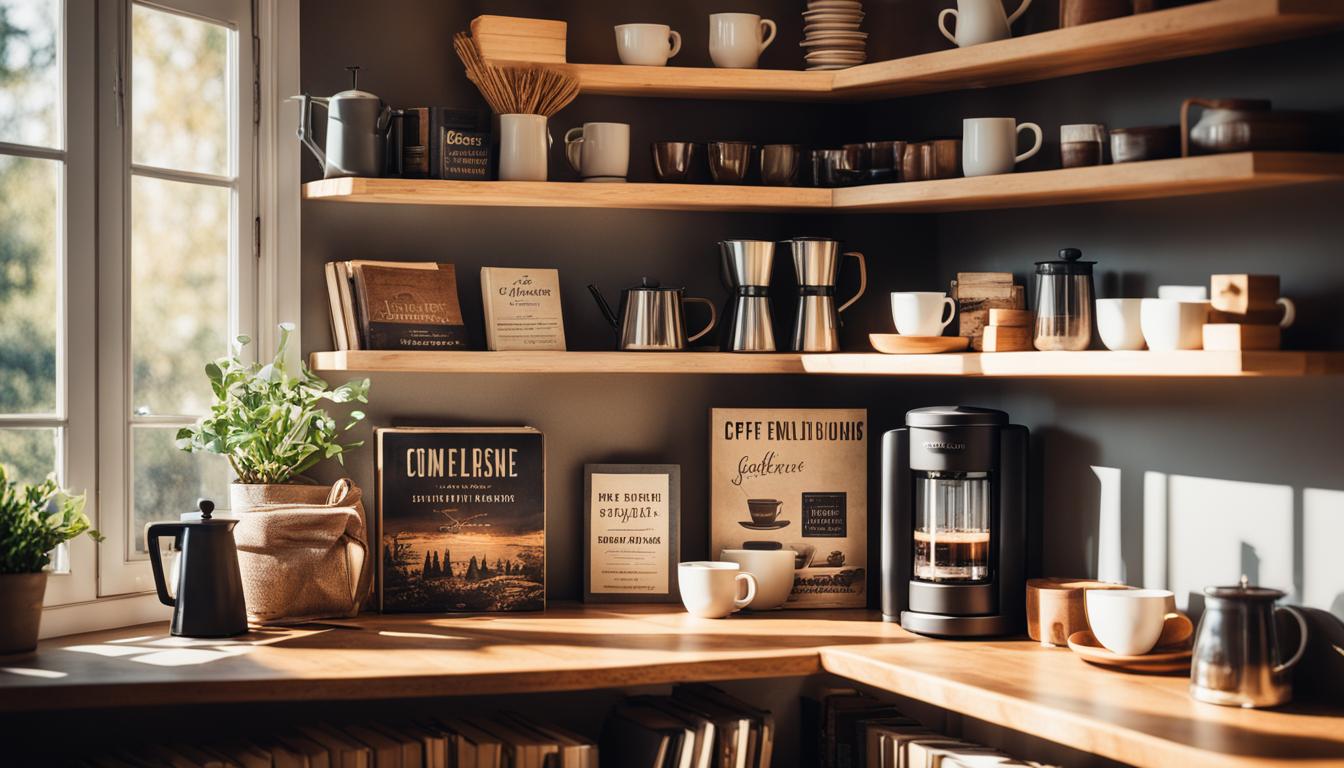Welcome to our guide on creative and eco-friendly ways to utilize leftover coffee. We all know the feeling of brewing a little too much coffee and being left with that regretful quotient at the bottom of the pot. But fear not! We’ve got some exciting ideas to help you make the most of every drop, reduce waste, and embrace sustainable coffee practices.
From repurposing coffee grounds in unexpected ways to discovering delicious recipes that incorporate your leftover coffee, we’re here to inspire you. So, let’s dive in and uncover the limitless possibilities of utilizing leftover coffee in imaginative and eco-friendly ways.
Key Takeaways:
- Discover creative uses for coffee grounds in your home beyond brewing.
- Learn delicious recipes that make the most of leftover coffee.
- Find practical tips to reduce coffee waste and promote sustainability.
- Explore how to compost coffee grounds for a greener garden.
- Embrace eco-friendly coffee practices and contribute to a sustainable future.
Repurposing Coffee Grounds for Household Use
Discover the many practical uses for coffee grounds in your home beyond brewing a cup of joe. Coffee grounds are a versatile and eco-friendly ingredient that can be repurposed in various ways, making them a sustainable choice for coffee enthusiasts.
1. Natural Exfoliant
Coffee grounds are an excellent natural exfoliant for your skin. The coarse texture helps remove dead skin cells, leaving your skin feeling smooth and rejuvenated. To create a simple coffee scrub, combine coffee grounds with a small amount of oil (such as olive or coconut oil) and gently massage onto your skin in circular motions. Rinse off for soft, glowing skin.
2. Plant Fertilizer
Instead of throwing away your coffee grounds, give them a second life as a plant fertilizer. Coffee grounds contain valuable nutrients like nitrogen, potassium, and phosphorus, which can enrich the soil and promote healthy plant growth. Simply sprinkle the coffee grounds around the base of your plants or mix them into the soil to provide a nutrient boost.
3. Odor Absorber
Are there unpleasant odors lingering in your home? Coffee grounds can come to the rescue as a natural odor absorber. Place a bowl of coffee grounds in the fridge, near your trash can, or in other areas where odors tend to linger. The coffee grounds will help absorb and neutralize unwanted smells, leaving your home smelling fresh.
4. Cleaning Scrub
Coffee grounds can be used as an effective and eco-friendly cleaning scrub. The abrasive texture of the grounds helps remove stubborn dirt and grime from various surfaces, including pots, pans, and countertops. Mix coffee grounds with a small amount of dish soap or baking soda to create a gentle yet powerful cleaning paste.
Consider these creative and sustainable uses for coffee grounds to reduce waste and embrace eco-friendly practices in your home.
| Coffee Grounds Uses | Benefits |
|---|---|
| Natural Exfoliant | Removes dead skin cells, leaving skin smooth and rejuvenated |
| Plant Fertilizer | Enriches soil with valuable nutrients for healthier plant growth |
| Odor Absorber | Helps eliminate unwanted odors in the home |
| Cleaning Scrub | Effectively cleans various surfaces |
Delicious Recipes with Leftover Coffee
Don’t let your leftover coffee go to waste! At Coffee Creations, we believe in embracing the unique flavor of coffee and finding creative ways to incorporate it into delicious recipes. Whether you’re a coffee enthusiast or just looking for new and exciting flavors to try, these mouth-watering recipes will satisfy your cravings and help you make the most of every drop of coffee.
1. Coffee Infused Brownies
Indulge in the irresistible combination of chocolate and coffee with our coffee-infused brownies. The rich and fudgy texture of these brownies is enhanced by the deep, aromatic flavor of leftover coffee. Simply substitute part of the liquid required in your favorite brownie recipe with leftover coffee, and you’ll be in for a treat!
2. Creamy Coffee Smoothie
Start your day with a refreshing and energizing creamy coffee smoothie. Blend together a ripe banana, a cup of leftover coffee, a splash of milk (or your favorite dairy-free alternative), and a drizzle of honey or maple syrup. The result is a smooth and creamy beverage that combines the bold flavor of coffee with the sweetness of bananas.
3. Coffee Marinated Steak
Take your grilled steak to the next level by marinating it in coffee. The acidity and bitterness of coffee help tenderize the meat while infusing it with a unique and complex flavor profile. Combine leftover coffee, soy sauce, garlic, and your favorite herbs and spices to create a flavorful marinade. Let the steak sit in the marinade for a few hours before grilling to perfection.
4. Mocha Popsicles
Cool down on a hot summer day with homemade mocha popsicles. Mix leftover coffee with chocolate syrup and a touch of sweetened condensed milk for a creamy and indulgent treat. Pour the mixture into popsicle molds, insert sticks, and freeze until solid. These frozen delights offer a delightful combination of coffee and chocolate flavors in a refreshing form.

These are just a few examples of the many creative ways you can use leftover coffee in your culinary adventures. The versatility of coffee allows you to experiment with different flavors and textures, adding a unique twist to your favorite recipes. So next time you have some leftover coffee, don’t let it go to waste – get creative in the kitchen and discover the incredible flavors that coffee can bring to your dishes!
Reducing Coffee Waste: Sustainable Practices
In our journey towards sustainable coffee use, it’s crucial to address the issue of coffee waste reduction. By implementing eco-friendly practices, we can minimize our environmental impact and contribute to a greener future. In this section, we will explore practical tips and habits that promote sustainability and help us make the most out of every cup of coffee.
Coffee waste can manifest in various forms, from leftover coffee to single-use coffee pods. It’s important to consider alternatives that minimize waste throughout the entire coffee-making process. Let’s explore some sustainable practices:
1. Ditch Single-Use Coffee Pods
Single-use coffee pods have gained popularity in recent years, but their convenience comes at a cost. These pods contribute to significant waste accumulation, as most of them are not easily recyclable. Instead, opt for reusable coffee pods or a traditional coffee maker that uses biodegradable filters, reducing the environmental impact of your daily caffeine fix.
2. Manage Leftover Coffee
Leftover coffee doesn’t have to go to waste. Consider these eco-friendly ways to repurpose your leftover brew:
- Use it in your favorite recipes to enhance the flavor of baked goods, sauces, or marinades.
- Freeze it in ice cube trays to make coffee-infused ice cubes that can be added to iced coffee or used to cool down hot beverages without diluting their flavor.
- Create homemade coffee scrubs or facial masks by mixing coffee grounds with natural ingredients like honey or coconut oil.
3. Embrace Eco-Friendly Brewing Methods
Eco-friendly brewing methods not only reduce coffee waste but also enhance the overall coffee experience. Consider the following sustainable brewing options:
- French Press: This brewing method requires no paper filters and produces a rich, full-bodied flavor.
- Pour-Over: Invest in a stainless steel or reusable cloth filter to eliminate the need for disposable paper filters.
- AeroPress: This portable and versatile coffee maker produces minimal waste and allows for easy cleanup.
“Sustainability is not just about reducing waste; it’s about creating a better future for the planet and future generations.” – Unknown
By adopting these sustainable practices, we can make a significant difference in coffee waste reduction and contribute to a more eco-friendly coffee industry. Let’s strive for a world where every sip of coffee brings us joy without compromising our planet.
Giving Back to the Earth: Composting Coffee Grounds
When it comes to sustainable coffee practices, repurposing coffee grounds is an eco-friendly solution that gives back to the earth. Composting coffee grounds not only reduces waste but also creates nutrient-rich soil for your garden. In this section, we’ll guide you through the process of effectively composting coffee grounds, highlighting their value and impact on our environment.
Composting is a natural process of decomposition that turns organic waste into a valuable soil amendment. Coffee grounds, with their high nitrogen content, make an excellent addition to your compost pile. As they break down, they contribute essential nutrients like nitrogen, potassium, and phosphorus, which promote plant growth and improve soil fertility.

Benefits of Composting Coffee Grounds
Composting coffee grounds offers several benefits for both your garden and the environment:
“Composting coffee grounds reduces waste, enriches soil, and benefits your garden.”
- Waste reduction: By composting coffee grounds, you divert them from landfills, where they would otherwise contribute to methane gas emissions.
- Nutrient enrichment: Coffee grounds add essential nutrients to your compost, improving its overall quality and providing a balanced source of nutrition for plants.
- Soil conditioning: Composted coffee grounds enhance soil structure, moisture retention, and drainage, creating optimal conditions for plant growth.
- Earthworm attraction: Coffee grounds are loved by earthworms, which help to aerate the soil and break down organic matter further.
Effective Composting Tips
Follow these tips to ensure your coffee grounds compost effectively:
- Balance your compost: Mix coffee grounds with other organic materials in your compost pile, such as leaves, grass clippings, and fruit/vegetable scraps, to maintain a proper carbon-to-nitrogen ratio.
- Avoid clumping: Spread coffee grounds evenly throughout your compost pile to prevent them from forming clumps and compacting the pile.
- Moisture management: Keep your compost pile moist but not wet by watering it regularly. Coffee grounds have a high moisture content, so monitor the moisture levels and adjust accordingly.
- Aerate the pile: Turn your compost pile regularly to provide oxygen and facilitate decomposition. This helps speed up the composting process, ensuring coffee grounds break down effectively.
By following these steps, you can harness the full potential of coffee grounds as compost, creating a nutrient-rich soil amendment that nourishes plants, reduces waste, and contributes to a more sustainable future.
| Composting Coffee Grounds Dos and Don’ts | |
|---|---|
| Do: | Don’t: |
|
|
Conclusion
In conclusion, there are numerous creative ways to make the most of leftover coffee and reduce coffee waste. By repurposing coffee grounds and exploring delicious recipes, we can adopt eco-friendly habits that contribute to a greener future. With a little creativity and resourcefulness, we can transform what might have been discarded into valuable assets in our homes and gardens.
Repurposing coffee grounds offers incredible possibilities for sustainable practices. From using them as a natural exfoliant to fertilizing plants, coffee grounds can serve multiple purposes in our daily lives. By incorporating these eco-friendly habits, we not only reduce waste but also minimize our environmental impact.
Furthermore, discovering delicious recipes that incorporate leftover coffee allows us to savor its unique flavor in unexpected ways. Whether it’s adding richness to baked goods or enhancing marinades, finding ways to include leftover coffee in our culinary adventures can be a delightful experience. This not only adds a delectable twist to our dishes but also ensures that no drop of coffee goes to waste.
Let’s embrace sustainable coffee practices and join the movement towards a greener future. By utilizing every part of the coffee-making process, from repurposing coffee grounds to enjoying leftover coffee in recipes, we have the power to make a positive impact on our environment. Together, we can reduce coffee waste, promote sustainability, and enjoy the benefits of our creative endeavors.
FAQ
What are some creative ways to utilize leftover coffee?
There are several creative ways to utilize leftover coffee. You can repurpose coffee grounds for household use, incorporate leftover coffee into delicious recipes, reduce coffee waste through sustainable practices, and even compost coffee grounds to enrich your garden. Let’s explore all these ideas in detail!
How can I repurpose coffee grounds for household use?
Coffee grounds can be repurposed for various household uses. They make excellent natural exfoliants for your skin, they absorb unwanted odors in your refrigerator, and can even be used as a natural fertilizer for plants. Stay tuned for more ideas on how to repurpose coffee grounds!
What are some delicious recipes that use leftover coffee?
Leftover coffee can add a unique and flavorful twist to many recipes. Some mouth-watering options include coffee-infused baked goods like brownies, cakes, and muffins, as well as adding it to smoothies, marinades for meat, or as an ingredient in savory sauces. Stay tuned for more inspiring recipes that use leftover coffee!
What are some sustainable practices to reduce coffee waste?
Reducing coffee waste is an important step towards sustainability. By avoiding single-use coffee pods, managing leftover coffee effectively, and adopting eco-friendly brewing methods like using a French press or pour-over, you can minimize coffee waste and contribute to a greener future. We’ll share more tips and habits to reduce coffee waste, so keep reading!
How can I compost coffee grounds?
Coffee grounds are an excellent addition to your compost pile as they add valuable nutrients to the soil. To compost coffee grounds effectively, mix them with other compostable materials, maintain the right moisture levels, and turn the pile regularly. We’ll provide more in-depth instructions on how to compost coffee grounds, so stay tuned!
How can I make the most of every drop of coffee while being eco-friendly?
By embracing sustainable coffee practices such as repurposing coffee grounds, exploring creative recipes with leftover coffee, reducing coffee waste, and composting coffee grounds, you can make the most of every drop of coffee while minimizing your impact on the environment. Together, let’s adopt eco-friendly habits and contribute to a greener future!




